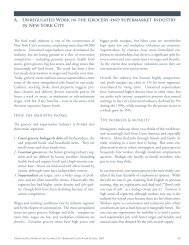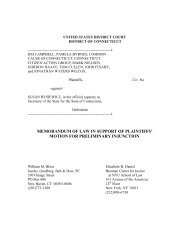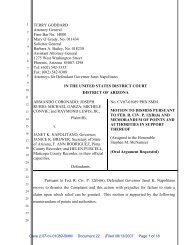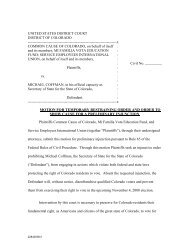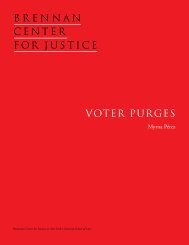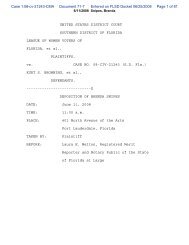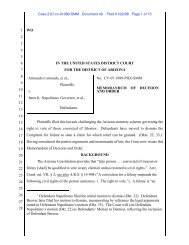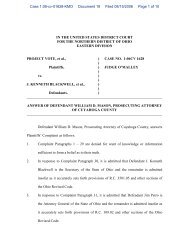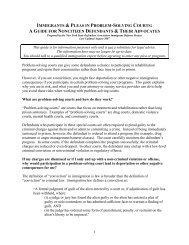Jim Crow in New York
Jim Crow in New York
Jim Crow in New York
Create successful ePaper yourself
Turn your PDF publications into a flip-book with our unique Google optimized e-Paper software.
<strong>Jim</strong><strong>Crow</strong><br />
<strong>in</strong><br />
<strong>New</strong><strong>York</strong><br />
By Erika Wood and Liz Budnitz<br />
with Garima Malhotra<br />
Introduction by Charles J. Ogletree, Jr.<br />
Harvard Law School<br />
at <strong>New</strong> <strong>York</strong> University School of Law
About the Brennan Center for Justice<br />
The Brennan Center for Justice at <strong>New</strong> <strong>York</strong> University School of Law is a non-partisan public<br />
policy and law <strong>in</strong>stitute that focuses on fundamental issues of democracy and justice. Our work<br />
ranges from vot<strong>in</strong>g rights to redistrict<strong>in</strong>g reform, from access to the courts to presidential power <strong>in</strong><br />
the fight aga<strong>in</strong>st terrorism. A s<strong>in</strong>gular <strong>in</strong>stitution – part th<strong>in</strong>k tank, part public <strong>in</strong>terest law firm,<br />
part advocacy group – the Brennan Center comb<strong>in</strong>es scholarship, legislative and legal advocacy,<br />
and communications to w<strong>in</strong> mean<strong>in</strong>gful, measurable change <strong>in</strong> the public sector.<br />
About the Right to Vote Project<br />
The Right to Vote Project leads a nationwide campaign to restore vot<strong>in</strong>g rights to people with<br />
crim<strong>in</strong>al convictions. Brennan Center staff counsels policymakers and advocates, provides legal<br />
and constitutional analysis, drafts legislation and regulations, engages <strong>in</strong> litigation challeng<strong>in</strong>g disenfranchis<strong>in</strong>g<br />
laws, surveys the implementation of exist<strong>in</strong>g laws, and promotes the restoration of<br />
vot<strong>in</strong>g rights through public outreach and education.<br />
© 2009. This paper is covered by the Creative Commons “Attribution-No Derivs-NonCommercial”<br />
license (see http://creativecommons.org). It may be reproduced <strong>in</strong> its entirety as long as the<br />
Brennan Center for Justice is credited, a l<strong>in</strong>k to the Center’s web page is provided, and no charge is<br />
imposed. The paper may not be reproduced <strong>in</strong> part or altered <strong>in</strong> form, or if a fee is charged, without<br />
the Center’s permission. Please let the Brennan Center for Justice know if you repr<strong>in</strong>t.
About the Authors<br />
Charles J. Ogletree, Jr. is the Harvard Law School Jesse Climenko Professor of Law and Director<br />
of the Crim<strong>in</strong>al Justice Institute. In addition, Professor Ogletree serves Harvard Law School as the<br />
Executive Director of the Charles Hamilton Houston Institute for Race and Justice as well as Director<br />
of the Trial Advocacy Workshop and Saturday School Program. Professor Ogletree is a prom<strong>in</strong>ent<br />
legal theorist who has made an <strong>in</strong>ternational reputation by tak<strong>in</strong>g a hard look at complex issues of law<br />
and by work<strong>in</strong>g to secure the rights guaranteed by the Constitution for everyone equally under the<br />
law. Professor Ogletree earned an M.A. and B.A. (with dist<strong>in</strong>ction) <strong>in</strong> Political Science from Stanford<br />
University, where he was Phi Beta Kappa. He also holds a J.D. from Harvard Law School where he<br />
served as Special Projects Editor of the Harvard Civil Rights - Civil Liberties Law Review. Professor<br />
Ogletree is the author of All Deliberate Speed: Refl ections on the First Half-Century of Brown v. Board<br />
of Education, co-author of the award-w<strong>in</strong>n<strong>in</strong>g book, Beyond the Rodney K<strong>in</strong>g Story: An Investigation of<br />
Police Conduct <strong>in</strong> M<strong>in</strong>ority Communities, and he frequently contributes to the Harvard Law Review,<br />
among other publications.<br />
Erika Wood is the Deputy Director of the Democracy Program at the Brennan Center for Justice<br />
where she directs the Right to Vote project and works on redistrict<strong>in</strong>g reform. Ms. Wood has designed<br />
and launched major reform campaigns around the country and provides legal counsel and<br />
strategic guidance to advocates, legislators and policymakers nationwide. She has authored several<br />
groundbreak<strong>in</strong>g reports, numerous articles and is a frequent speaker and commentator on vot<strong>in</strong>g<br />
rights, crim<strong>in</strong>al justice reform and racial justice issues. In 2009 Ms. Wood was awarded the Eric. R.<br />
Neisser Public Interest Award by Rutgers Law School <strong>in</strong> recognition of her efforts to carry forward<br />
the Law School’s mission of provid<strong>in</strong>g liberty and justice for all. Ms. Wood is an Adjunct Professor<br />
at NYU School of Law where she teaches the Brennan Center Public Policy Advocacy Cl<strong>in</strong>ic.<br />
Liz Budnitz was the 2008-2009 Right to Vote Fellow with the Democracy Program and she currently<br />
works for the Appeals Chamber at the International Crim<strong>in</strong>al Court <strong>in</strong> The Hague. Prior to<br />
jo<strong>in</strong><strong>in</strong>g the Brennan Center, Ms. Budnitz clerked for the Honorable Joan M. Azrack, Magistrate<br />
Judge <strong>in</strong> the Eastern District of <strong>New</strong> <strong>York</strong>. She graduated cum laude from Brooklyn Law School <strong>in</strong><br />
2006, where she was an Edward V. Sparer fellow.<br />
Garima Malhotra is a Research Associate with the Democracy Program where she works primarily<br />
on efforts to restore vot<strong>in</strong>g rights to people with crim<strong>in</strong>al convictions. Ms. Malhotra graduated from<br />
Cornell University <strong>in</strong> 2008, where she majored <strong>in</strong> American Government, with m<strong>in</strong>ors <strong>in</strong> Inequality<br />
and Law & Society. Previously, she worked at Project Vote where she focused on <strong>in</strong>creas<strong>in</strong>g voter<br />
registration among low <strong>in</strong>come and m<strong>in</strong>ority citizens. Ms. Malhotra has also spent a summer work<strong>in</strong>g<br />
for AmeriCorps’ Breakthrough Collaborative program <strong>in</strong> Philadelphia’s public school district.
Acknowledgments<br />
The authors gratefully acknowledge the contributions of Charles J. Ogletree, Jr., Professor of Law,<br />
Harvard Law School, David Harris, Manag<strong>in</strong>g Director, Charles Hamilton Houston Institute for<br />
Race and Justice at Harvard Law School, Darrick North<strong>in</strong>gton, Harvard Law School, David Gellman,<br />
Associate Professor, DePauw University, David Quigley, Professor, Boston College, as well as the<br />
historians and archivists at the <strong>New</strong> <strong>York</strong> Historical Society, the <strong>New</strong> <strong>York</strong> State Archives and the <strong>New</strong><br />
<strong>York</strong> State Library. We also thank Ryan Haygood of NAACP-LDF and Juan Cartagena of the Community<br />
Service Society, and Michael Waldman, Frederick A.O. Schwarz, Jr., Susan Lehman, Myrna<br />
Pérez, Jean<strong>in</strong>e Plant-Chirl<strong>in</strong>, Jonathan Blitzer, Laura Seago, Theresa Lee, D<strong>in</strong>a Hardy, Daniel Wolf,<br />
Crist<strong>in</strong>a Gallo, Ben Guthorn and Sarah Nadler, all of the Brennan Center for Justice.<br />
The Brennan Center thanks Atlantic Philanthropies, Carnegie Corporation of <strong>New</strong> <strong>York</strong>, Democracy<br />
Alliance, Educational Foundation of America, Ford Foundation, Mitchell Kapor Foundation, Moveon.org<br />
Civic Action, Open Society Institute and an anonymous donor for their generous support<br />
that made this report possible. The statements made and views expressed <strong>in</strong> this report are solely the<br />
responsibility of the Brennan Center.
Table of Contents<br />
I. Introduction 1<br />
II. <strong>Jim</strong> <strong>Crow</strong> <strong>in</strong> <strong>New</strong> <strong>York</strong> 3<br />
Discrim<strong>in</strong>atory Beg<strong>in</strong>n<strong>in</strong>gs: <strong>New</strong> <strong>York</strong>’s 1777 Constitution 5<br />
and the Voter “Fraud” Act<br />
The Debates of the 1821 Convention: 6<br />
“The M<strong>in</strong>ds of Blacks Are Not Competent to Vote.”<br />
1846: Emancipated, But Still Disenfranchised 9<br />
Violent Resentment of the Civil War and its Aftermath 11<br />
1872: A Bait and Switch 12<br />
Last<strong>in</strong>g Effects 14<br />
III. Recommendations 16<br />
IV. Endnotes 17
Introduction<br />
One of the most extraord<strong>in</strong>ary moments of my life came a year ago as I witnessed my fellow citizens<br />
elect my former student, Barack Obama, as the President of the United States of America. More<br />
African-American and Lat<strong>in</strong>o voters cast a ballot <strong>in</strong> that election than <strong>in</strong> any other election <strong>in</strong> the<br />
country’s history. Then, this June, I experienced great relief as the United States Supreme Court<br />
upheld the constitutionality of Section 5 of the Vot<strong>in</strong>g Rights Act by an 8-1 marg<strong>in</strong>, thus preserv<strong>in</strong>g<br />
our commitment as a nation to vigilantly enforce the vot<strong>in</strong>g rights of all citizens. This is a good<br />
year for all of us who have struggled for an equitable and fair distribution of the franchise.<br />
But protect<strong>in</strong>g the rights of m<strong>in</strong>ority voters is still a full-time job. And, lest we lose our sense of urgency,<br />
the Brennan Center for Justice’s remarkable new report on the historical roots of felony disenfranchisement<br />
<strong>in</strong> the Empire State, <strong>Jim</strong> <strong>Crow</strong> <strong>in</strong> <strong>New</strong> <strong>York</strong>, rem<strong>in</strong>ds us that there is still much work to<br />
do. Felony disenfranchisement laws have stripped the right to vote from two million black Americans.<br />
This number <strong>in</strong>cludes 13% of all African-American men. In <strong>New</strong> <strong>York</strong>, 80% of the roughly 100,000<br />
adults who have lost their right to participate <strong>in</strong> self-government because of a crim<strong>in</strong>al conviction are<br />
black or Lat<strong>in</strong>o. At a time when we congratulate ourselves as a society on our progress <strong>in</strong> the struggle<br />
for racial equality, those of us who refuse to be satisfied until all votes – and all people – are of equal<br />
worth must reenergize to fight aga<strong>in</strong>st felony disenfranchisement laws.<br />
Some might ask why we should be troubled by the high percentage of African Americans who are<br />
disenfranchised because of prior convictions. Isn’t the salient factor crim<strong>in</strong>ality Black, White, Lat<strong>in</strong>o,<br />
or Asian, why should any crim<strong>in</strong>al who is still under the supervision of the state be given the<br />
right to participate <strong>in</strong> government <strong>Jim</strong> <strong>Crow</strong> <strong>in</strong> <strong>New</strong> <strong>York</strong> beg<strong>in</strong>s to answer that question.<br />
When a law can be traced clearly to a racially discrim<strong>in</strong>atory start-po<strong>in</strong>t, the burden of prov<strong>in</strong>g the<br />
absence of racial ta<strong>in</strong>t <strong>in</strong> the current operation of the law should fall on those who seek to justify its<br />
cont<strong>in</strong>ued existence. As readers will discover <strong>in</strong> the pages that follow, suppress<strong>in</strong>g the black vote is<br />
not a legislative purpose that was limited to the deep South. In response to the abolition of slavery<br />
and the passage of the Reconstruction Amendments, legislators <strong>in</strong> <strong>New</strong> <strong>York</strong> sought to prevent free<br />
blacks from vot<strong>in</strong>g by any means possible. And while laws prevent<strong>in</strong>g crim<strong>in</strong>als from vot<strong>in</strong>g extend<br />
back far before the Civil War, those measures are truly benign <strong>in</strong> comparison to the scope and target<br />
of the laws that cont<strong>in</strong>ue to impact – true to their <strong>in</strong>tent – a disproportionate number of would-be<br />
m<strong>in</strong>ority voters today.<br />
This mass silenc<strong>in</strong>g of black Americans is even more troubl<strong>in</strong>g when viewed through the lens of<br />
a discrim<strong>in</strong>atory justice system. Black Americans – and other people of color – are often the recipients<br />
of uneven treatment at all stages of the crim<strong>in</strong>al justice process. From police profil<strong>in</strong>g of<br />
<strong>in</strong>dividuals and communities of color, to the severity of charges brought, the juries selected for trial,<br />
and the punishments imposed, disparate adm<strong>in</strong>istration of the laws results <strong>in</strong> hugely disproportionate<br />
numbers of people of color who are under the supervision of the crim<strong>in</strong>al justice system.<br />
1<br />
Brennan Center for Justice
But racial fairness is not the only reason to advocate for the end of felony disenfranchisement laws.<br />
When people with crim<strong>in</strong>al convictions re-enter society after periods of <strong>in</strong>carceration, although<br />
often jobless, isolated, and broken, they must beg<strong>in</strong> to re-connect and re-engage with their communities.<br />
We have a stake <strong>in</strong> whether they succeed. Hous<strong>in</strong>g <strong>in</strong>dividuals who commit a crime costs<br />
an exorbitant percentage of our taxpayer revenue – money that can be better spent improv<strong>in</strong>g our<br />
schools or putt<strong>in</strong>g more police officers on the street. Yet, one-third of <strong>in</strong>dividuals released from<br />
prison are re-arrested with<strong>in</strong> three years. We can and must do better. Provid<strong>in</strong>g all people who reside<br />
<strong>in</strong> the community with a share <strong>in</strong> the responsibility of government and a voice <strong>in</strong> the outcome<br />
of community decisions (especially at the local level) <strong>in</strong>creases the likelihood of a smooth transition<br />
from “felon” to stakeholder and productive citizen.<br />
Aga<strong>in</strong>st these strong historical and practical reasons to re-exam<strong>in</strong>e our adherence to crim<strong>in</strong>al disenfranchisement,<br />
some cont<strong>in</strong>ue to argue that extend<strong>in</strong>g the vote to all citizens who live <strong>in</strong> the<br />
community will result <strong>in</strong> a dilution of the social order and debasement of the privilege of vot<strong>in</strong>g.<br />
But these arguments do not withstand careful scrut<strong>in</strong>y. As Justice Thurgood Marshall rem<strong>in</strong>ded<br />
us nearly four decades ago, “[t]he ballot is the democratic system’s co<strong>in</strong> of the realm. To condition<br />
its exercise on support of the established order is to debase that currency beyond recognition.” Indeed,<br />
restor<strong>in</strong>g the right to vote to all of us who live and pay taxes <strong>in</strong> the community will have the<br />
predictable and desirable effect of reduc<strong>in</strong>g discrim<strong>in</strong>ation <strong>in</strong> the adm<strong>in</strong>istration of crim<strong>in</strong>al laws<br />
and <strong>in</strong>creas<strong>in</strong>g the participation levels of m<strong>in</strong>ority voters. The upshot would be a lot fewer people<br />
of color to disenfranchise.<br />
Charles J. Ogletree, Jr.,<br />
Jesse Climenko Professor of Law, Harvard Law School<br />
<strong>Jim</strong> <strong>Crow</strong> <strong>in</strong> <strong>New</strong> <strong>York</strong> 2
It is widely known and well documented that Americans used the law to<br />
keep African-American voters out of the electoral process throughout the<br />
Deep South. In the late 1800s, <strong>Jim</strong> <strong>Crow</strong> laws spread as part of a backlash<br />
aga<strong>in</strong>st the Reconstruction Amendments – the Thirteenth, Fourteenth,<br />
and Fifteenth Amendments of the U.S. Constitution – which<br />
ended slavery, granted equal citizenship to freed slaves, and prohibited<br />
racial discrim<strong>in</strong>ation <strong>in</strong> vot<strong>in</strong>g. 1 The uproar worked its <strong>in</strong>tended purpose:<br />
large segments of the African-American population were effectively<br />
removed from the democratic process for susta<strong>in</strong>ed periods, <strong>in</strong> some cases<br />
for life. 2<br />
Less known is that crim<strong>in</strong>al disenfranchisement laws were part of the<br />
effort to ma<strong>in</strong>ta<strong>in</strong> white control over access to the polls. 3 Between 1865<br />
and 1900, a period when African-American men were, theoretically,<br />
granted greater vot<strong>in</strong>g rights state-by-state, and ultimately enfranchised<br />
by the Fifteenth Amendment, 19 states passed crim<strong>in</strong>al disenfranchisement<br />
laws. By 1900, 38 states deployed some type of crim<strong>in</strong>al vot<strong>in</strong>g<br />
restriction. 4 These laws disenfranchised convicted <strong>in</strong>dividuals long after<br />
their release from prison; many dictated that <strong>in</strong>dividuals released from<br />
prison could not vote unless they had been pardoned by the governor. 5<br />
<strong>Jim</strong> <strong>Crow</strong> laws<br />
worked their <strong>in</strong>tended<br />
purpose: large<br />
segments of the<br />
African-American<br />
population were<br />
effectively removed<br />
from the democratic<br />
process for susta<strong>in</strong>ed<br />
periods – <strong>in</strong> some<br />
cases for life.<br />
States also adapted their crim<strong>in</strong>al codes to punish those offenses with<br />
which they believed freedmen were likely to be charged, <strong>in</strong>clud<strong>in</strong>g bigamy,<br />
vagrancy, petty theft and burglary. 6 Together, targeted crim<strong>in</strong>alization<br />
and felony disenfranchisement stripped African Americans of their<br />
vot<strong>in</strong>g rights – and suppressed African American’s political power for<br />
decades. 7 The discrim<strong>in</strong>atory impact of these laws and practices cont<strong>in</strong>ues<br />
to this day. Nationwide, 8% of the African-American population, or<br />
2,000,000 African Americans, are disenfranchised. 8 Given current rates<br />
of <strong>in</strong>carceration, approximately one <strong>in</strong> three of the next generation of<br />
black men will be disenfranchised at some po<strong>in</strong>t dur<strong>in</strong>g their lifetime.<br />
But <strong>Jim</strong> <strong>Crow</strong> was not conf<strong>in</strong>ed to the South. He made his home <strong>in</strong><br />
northern states as well, perhaps most notably <strong>in</strong> <strong>New</strong> <strong>York</strong>. Start<strong>in</strong>g <strong>in</strong><br />
the 18th century, the history of <strong>New</strong> <strong>York</strong>’s election laws follows this<br />
national narrative. In fact, <strong>New</strong> <strong>York</strong> was the only state <strong>in</strong> the country<br />
to require blacks – and only blacks – to own real property <strong>in</strong> order to<br />
qualify to vote.<br />
<strong>Jim</strong> <strong>Crow</strong> was not<br />
confi ned to the South.<br />
<strong>New</strong> <strong>York</strong>’s crim<strong>in</strong>al disenfranchisement provisions, like those deployed<br />
<strong>in</strong> the South, were part of a concerted effort to exclude African Americans<br />
from participat<strong>in</strong>g <strong>in</strong> the political process. As African Americans<br />
ga<strong>in</strong>ed freedom with the gradual end of slavery, <strong>New</strong> <strong>York</strong>’s vot<strong>in</strong>g qualifications<br />
– <strong>in</strong>clud<strong>in</strong>g crim<strong>in</strong>al disenfranchisement laws – became <strong>in</strong>creas<strong>in</strong>gly<br />
more restrictive. A careful read<strong>in</strong>g of <strong>New</strong> <strong>York</strong>’s constitutional<br />
history reveals that at the very time that the Fourteenth and Fifteenth<br />
<strong>Jim</strong> <strong>Crow</strong> <strong>in</strong> <strong>New</strong> <strong>York</strong><br />
4
Amendments forced the state to remove its nefarious property requirements<br />
for African-American voters, <strong>New</strong> <strong>York</strong> changed its law from<br />
allow<strong>in</strong>g to requir<strong>in</strong>g the disenfranchisement of those convicted of “<strong>in</strong>famous<br />
crimes.”<br />
Today, <strong>New</strong> <strong>York</strong>’s<br />
crim<strong>in</strong>al disenfranchisement<br />
law is<br />
nearly identical to<br />
the provision enacted<br />
140 years ago.<br />
And it cont<strong>in</strong>ues to<br />
disenfranchise<br />
large numbers of<br />
African Americans<br />
and other ethnic<br />
m<strong>in</strong>orities.<br />
Today, <strong>New</strong> <strong>York</strong>’s crim<strong>in</strong>al disenfranchisement law is nearly identical to<br />
the provision enacted 140 years ago. And the law cont<strong>in</strong>ues to have its<br />
orig<strong>in</strong>ally <strong>in</strong>tended effect: the widespread disenfranchisement of African<br />
Americans and other ethnic m<strong>in</strong>orities. More than 108,000 <strong>New</strong> <strong>York</strong>ers<br />
cannot vote because of a conviction <strong>in</strong> their past. 9 Almost half of these<br />
disenfranchised citizens have completed their prison sentence and are<br />
liv<strong>in</strong>g and work<strong>in</strong>g <strong>in</strong> the community. 10 Nearly 80% of those who have<br />
lost their right to vote under <strong>New</strong> <strong>York</strong>’s law are African-American or<br />
Hispanic. 11<br />
Discrim<strong>in</strong>atory Beg<strong>in</strong>n<strong>in</strong>gs: <strong>New</strong> <strong>York</strong>’s 1777<br />
Constitution and the Voter “Fraud” Act<br />
The first <strong>New</strong> <strong>York</strong> State Constitution was adopted <strong>in</strong> 1777 and limited<br />
the franchise to any “freeman.” 12 It required all voters to pay taxes to the<br />
state and own real property <strong>in</strong> their county of residence. 13 Although free<br />
black men were technically allowed to vote, virtually none owned real<br />
property at the time and thus blacks effectively were disenfranchised under<br />
the state constitution. 14<br />
In 1799, the <strong>New</strong> <strong>York</strong> legislature passed a law provid<strong>in</strong>g for the gradual<br />
emancipation of slaves. The law conta<strong>in</strong>ed no mention of black vot<strong>in</strong>g<br />
rights and the constitutional property qualifications for vot<strong>in</strong>g rema<strong>in</strong>ed<br />
unchanged. 15 The gradual emancipation law did not free all slaves; <strong>in</strong>stead,<br />
it freed children born of slave mothers after 1799, but required<br />
these children to rema<strong>in</strong> slaves until their mid-twenties. 16<br />
Over the next decade, the free black population grew steadily <strong>in</strong> <strong>New</strong><br />
<strong>York</strong>, tripl<strong>in</strong>g between 1790 and 1800 and then doubl<strong>in</strong>g aga<strong>in</strong> dur<strong>in</strong>g<br />
the course of the next decade. 17 Although race and suffrage had not been<br />
legally l<strong>in</strong>ked before, <strong>in</strong> 1811 the state legislature passed the “Act to Prevent<br />
Frauds and Perjuries at Elections.” 18 Under the guise of prevent<strong>in</strong>g voter<br />
fraud, this law was designed to depress black voter turnout by rais<strong>in</strong>g obstacles<br />
targeted specifically at African Americans. Before vot<strong>in</strong>g, blacks had<br />
to obta<strong>in</strong> a document certify<strong>in</strong>g their freed status from a “supreme court<br />
justice, mayor, recorder, or … court of common pleas,” pay a fee and present<br />
the documentation at the polls. 19 The law realized its <strong>in</strong>tended effect:<br />
the few black men who were on the voter rolls effectively dropped off. 20<br />
5<br />
Brennan Center for Justice
The Debates of the 1821 Convention:<br />
“The M<strong>in</strong>ds of Blacks Are Not Competent to Vote.”<br />
When the <strong>New</strong> <strong>York</strong> legislature f<strong>in</strong>ally passed a universal emancipation<br />
bill <strong>in</strong> 1817, the f<strong>in</strong>al date for liberty of all slaves <strong>in</strong> the state was set for<br />
July 4, 1827. 21 Aga<strong>in</strong>, the bill made no mention of vot<strong>in</strong>g rights for the<br />
freed slaves.<br />
Meanwhile, the franchise began to open, dramatically, across the country.<br />
Urban populations swelled with grow<strong>in</strong>g numbers of laborers and merchants,<br />
many of whom owned no property. The result was an <strong>in</strong>creas<strong>in</strong>gly<br />
large and prom<strong>in</strong>ent slice of the population that was disqualified from<br />
vot<strong>in</strong>g. Comb<strong>in</strong>ed with the formation of broadly based political parties<br />
compet<strong>in</strong>g for votes, the swell<strong>in</strong>g ranks of disenfranchised citizens provoked<br />
many states to elim<strong>in</strong>ate their property requirements. 22 Between<br />
1790 and 1850, every state <strong>in</strong> the union held at least one constitutional<br />
convention; laws requir<strong>in</strong>g eligible voters to own property began to be<br />
dismantled state-by-state. 23<br />
Dur<strong>in</strong>g this period, <strong>New</strong> <strong>York</strong> was home to the largest number of blacks<br />
of all the northern states, <strong>in</strong>clud<strong>in</strong>g nearly 30,000 “free persons of color”<br />
and some 10,000 slaves due to be freed <strong>in</strong> 1827. 24 More African Americans<br />
– slaves and free blacks – were concentrated <strong>in</strong> <strong>New</strong> <strong>York</strong> City at this<br />
time than anywhere else <strong>in</strong> the country except Charleston, South Carol<strong>in</strong>a.<br />
25 The black vote was a small fraction of the total electorate. But, <strong>in</strong><br />
a close election, it could sw<strong>in</strong>g key districts and even decide the balance<br />
of power <strong>in</strong> the state assembly. 26<br />
By 1820, <strong>New</strong> <strong>York</strong> was one of n<strong>in</strong>e states (out of the twenty-three<br />
states then exist<strong>in</strong>g) that cont<strong>in</strong>ued to impose property qualifications<br />
on all voters. 27 Four years after the 1817 emancipation law was enacted,<br />
<strong>New</strong> <strong>York</strong> held another constitutional convention at which suffrage<br />
was the central concern.<br />
At the <strong>New</strong> <strong>York</strong> Constitutional Convention <strong>in</strong> 1821, the Committee<br />
on the Elective Franchise proposed elim<strong>in</strong>at<strong>in</strong>g property requirements<br />
and extend<strong>in</strong>g suffrage to every white male citizen of the state, for the<br />
first time explicitly disenfranchis<strong>in</strong>g all black men. 28 This proposal was<br />
one of the Convention’s most controversial. The delegates, <strong>New</strong> <strong>York</strong>’s<br />
lead<strong>in</strong>g politicians elected to represent their counties at the Convention,<br />
engaged <strong>in</strong> a fierce debate over the right of suffrage and equality for African<br />
Americans.<br />
<strong>Jim</strong> <strong>Crow</strong> <strong>in</strong> <strong>New</strong> <strong>York</strong> 6
Delegate John Ross argued that the franchise must be limited to white<br />
men because:<br />
[Blacks] are a peculiar people, <strong>in</strong>capable, <strong>in</strong> my judgment, of<br />
exercis<strong>in</strong>g that privilege with any sort of discretion, prudence,<br />
or <strong>in</strong>dependence. They have no just conceptions of civil liberty.<br />
They know not how to appreciate it, and are consequently<br />
<strong>in</strong>different to its preservation. 29<br />
Delegate Samuel Young agreed, stat<strong>in</strong>g:<br />
Given current rates<br />
of <strong>in</strong>carceration,<br />
approximately one <strong>in</strong><br />
three of the next<br />
generation of black<br />
men will be<br />
disenfranchised at<br />
some po<strong>in</strong>t dur<strong>in</strong>g<br />
their lifetime.<br />
The m<strong>in</strong>ds of the blacks are not competent to vote. They are too<br />
much degraded to estimate the value, or exercise with fidelity and<br />
discretion that important right. It would be unsafe <strong>in</strong> their hands. 30<br />
Delegate Peter R. Liv<strong>in</strong>gston made similar arguments, ask<strong>in</strong>g delegates to:<br />
[L]ook at that people, and ask your consciences if they are<br />
competent to vote. Ask yourselves honestly, whether they have<br />
<strong>in</strong>telligence to discern, or purity of pr<strong>in</strong>ciple to exercise, with<br />
safety, that important right. 31<br />
In comments that r<strong>in</strong>g with a special irony today, Delegate Olney Briggs<br />
stated:<br />
[I]t was said that the right of suffrage would elevate them.<br />
He would ask whether it would elevate a monkey or a baboon<br />
to allow them to vote. No, it would be to sport, and trifle, and<br />
<strong>in</strong>sult them, to say that they might be candidates for the office<br />
of president of the United States. 32<br />
Importantly, dur<strong>in</strong>g the debate several of the delegates po<strong>in</strong>ted to alleged<br />
crim<strong>in</strong>al propensities as a reason to restrict the black vote. In a refra<strong>in</strong><br />
that echoes throughout the centuries-long suffrage debate, Delegate<br />
Young implored, “[l]ook to your jails and penitentiaries. By whom are<br />
they filled By the very race whom it is now proposed to cloth with the<br />
power of decid<strong>in</strong>g upon your political rights.” 33<br />
Delegate Liv<strong>in</strong>gston concurred:<br />
Survey your prisons – your alms-houses – your bridewells and<br />
your penitentiaries, and what a darken<strong>in</strong>g host meets your eye!<br />
More than one-third of the convicts and felons which those<br />
walls enclose, are of your sable population. 34<br />
7<br />
Brennan Center for Justice
Several delegates argued <strong>in</strong> favor of black vot<strong>in</strong>g rights. Peter Jay, son of<br />
former <strong>New</strong> <strong>York</strong> Governor John Jay, emerged as the most outspoken<br />
opponent of black disenfranchisement at the Convention:<br />
Why, sir, are these men to be excluded from rights which they<br />
possess <strong>in</strong> common with their countrymen … Why are they,<br />
who were born as free as ourselves, natives of the same country<br />
… now to be deprived of all those rights, and doomed to rema<strong>in</strong><br />
forever as aliens among us 35<br />
In an argument that cont<strong>in</strong>ues to resound today, Delegate Abraham Van<br />
Vechten contended that those who pay taxes and live and work <strong>in</strong> <strong>New</strong><br />
<strong>York</strong> communities should be entitled to vote:<br />
Are they not taxable, and do not many of them pay their proportion<br />
of taxes <strong>in</strong> common with white citizens … Do we<br />
not daily see them work<strong>in</strong>g side by side with white citizens on<br />
our farms, and on our public highways … How then can that<br />
dist<strong>in</strong>ction justify us <strong>in</strong> tak<strong>in</strong>g from them any of the common<br />
rights which every other free citizen enjoys 36<br />
Delegate Robert Clark agreed, stat<strong>in</strong>g:<br />
[I]s it consistent with sound policy, to compel a large portion<br />
of your people and their posterity, forever to become your enemies,<br />
and to view you and your political <strong>in</strong>stitutions with distrust,<br />
jealousy … to alienate one portion of the community …<br />
from their own political <strong>in</strong>stitutions 37<br />
The proposal to disenfranchise all black men by add<strong>in</strong>g the word “white”<br />
to the Constitution’s vot<strong>in</strong>g requirements narrowly failed, by a vote of<br />
63 to 59. 38 Nevertheless, the delegates severely restricted the black vote<br />
<strong>in</strong> two important ways. First, the Convention elim<strong>in</strong>ated the property<br />
qualifications for all white men, while simultaneously enact<strong>in</strong>g steep<br />
property qualifications specifically for black men. These new qualifications<br />
required all black men to possess a freehold estate with a m<strong>in</strong>imum<br />
value of $250.00 (equivalent to about $4,000.00 <strong>in</strong> 2009 dollar value). 39<br />
In fact, <strong>New</strong> <strong>York</strong> was the only state at this time to impose property qualifications<br />
exclusively on African-American men. 40 Second, a provision was<br />
added to the state Constitution stat<strong>in</strong>g: “[l]aws may be passed, exclud<strong>in</strong>g<br />
from the right of suffrage, persons who have been, or may be, convicted<br />
of <strong>in</strong>famous crimes.” 41 The first crim<strong>in</strong>al disenfranchisement provision <strong>in</strong><br />
the <strong>New</strong> <strong>York</strong> State Constitution was born.<br />
<strong>Jim</strong> <strong>Crow</strong> <strong>in</strong> <strong>New</strong> <strong>York</strong> 8
1846: Emancipated, But Still Disenfranchised<br />
Say<strong>in</strong>g there was<br />
“more vice among<br />
colored people than<br />
whites, <strong>in</strong> proportion<br />
to the population of<br />
each respectively,”<br />
Delegate Kennedy,<br />
at <strong>New</strong> <strong>York</strong>’s 1821<br />
Convention, detailed<br />
the number of black<br />
convicts <strong>in</strong> city jails<br />
and state prisons.<br />
In 1827, <strong>New</strong> <strong>York</strong> ended slavery once and for all. 42 Still, the <strong>New</strong> <strong>York</strong><br />
Constitution required black men – and only black men – to own property<br />
<strong>in</strong> order to vote. The crim<strong>in</strong>al disenfranchisement provision rema<strong>in</strong>ed <strong>in</strong><br />
place. 43 Another Constitutional Convention was called <strong>in</strong> 1846. Almost<br />
twenty years after <strong>New</strong> <strong>York</strong>’s abolition of slavery, delegates to the Convention<br />
still refused to elim<strong>in</strong>ate the discrim<strong>in</strong>atory vot<strong>in</strong>g restrictions. There<br />
were two compet<strong>in</strong>g suffrage proposals at the 1846 Convention. One<br />
sought to amend the constitution to limit suffrage to “[e]very white male<br />
citizen of the age of twenty-one” and the other sought to enfranchise black<br />
men by elim<strong>in</strong>at<strong>in</strong>g the property qualifications. 44 Although it had been 25<br />
years s<strong>in</strong>ce the last Convention, the debate suggests little had changed <strong>in</strong><br />
the delegates’ attitudes toward their African-American neighbors.<br />
Delegate John Kennedy pled:<br />
To permit the Ethiopian race to become an important portion<br />
of the govern<strong>in</strong>g power of the state! To allow that race,<br />
the farthest removed from us <strong>in</strong> sympathy and relationship of<br />
all <strong>in</strong>to which the human family is divided, to become a participant<br />
<strong>in</strong> govern<strong>in</strong>g, not themselves, but us! Nature revolted<br />
at the proposal. 45<br />
Delegate Kennedy then cont<strong>in</strong>ued the theme <strong>in</strong>troduced dur<strong>in</strong>g the<br />
1821 Convention, l<strong>in</strong>k<strong>in</strong>g his opposition to black suffrage to an alleged<br />
crim<strong>in</strong>al propensity. Say<strong>in</strong>g there was “more vice among colored people<br />
than whites, <strong>in</strong> proportion to the population of each respectively,” Delegate<br />
Kennedy detailed the number of black convicts <strong>in</strong> city jails and state<br />
prisons. 46 Accord<strong>in</strong>g to Delegate Kennedy, blacks were more than three<br />
and a half times more likely than whites to be <strong>in</strong>carcerated <strong>in</strong> <strong>New</strong> <strong>York</strong><br />
City jails for m<strong>in</strong>or crimes. 47 Delegate Kennedy also po<strong>in</strong>ted to the disproportionate<br />
number of blacks <strong>in</strong> the state prisons, stat<strong>in</strong>g “the relative<br />
proportion of <strong>in</strong>famous crime is nearly thirteen and a half times as great<br />
<strong>in</strong> the colored population as <strong>in</strong> the white.” 48 He then concluded that this<br />
statistic “conta<strong>in</strong>ed evidence of a crim<strong>in</strong>al disposition <strong>in</strong> the race” that he<br />
had “never before rightly appreciated.” 49<br />
Representative John Hunt <strong>in</strong>voked fear that blacks would dom<strong>in</strong>ate government<br />
if allowed to vote:<br />
We want … no masters, and least of all no negro masters, to<br />
reign over us. We contend for self-government … we will not<br />
meddle with their government <strong>in</strong> St. Dom<strong>in</strong>go nor <strong>in</strong> Africa,<br />
and, if we can prevent it, they shall not meddle with ours. 50<br />
9<br />
Brennan Center for Justice
As <strong>in</strong> the previous Convention, a few delegates rose to argue <strong>in</strong> favor of<br />
remov<strong>in</strong>g the property qualifications for blacks. Delegate Federal Dana<br />
attributed the large number of blacks <strong>in</strong> prison to their mistreatment dur<strong>in</strong>g<br />
slavery and <strong>in</strong> the courts. 51 Delegate George A. Simmons eloquently<br />
op<strong>in</strong>ed that “[p]olitical slavery was but one remove from civil slavery.” 52<br />
In the end, the proposal to amend the Constitution to elim<strong>in</strong>ate the<br />
property requirements and enfranchise black men was defeated 53 to<br />
30. 53 But the delegates reached an agreement and adopted a resolution<br />
provid<strong>in</strong>g that a proposed constitutional amendment would be put to<br />
the voters at the next general election.<br />
The proposed amendment read:<br />
Colored male citizens possess<strong>in</strong>g [age and citizen] qualifications<br />
… other than the property qualification, shall have the<br />
right to vote for all officers that now are, or hereafter may be,<br />
elective by the people after the first day of January 1847. 54<br />
Voters rejected the proposed enfranchisement amendment by a landslide<br />
vote of 223,834 to 85,306. Property qualifications for blacks rema<strong>in</strong>ed<br />
<strong>in</strong> place. 55 By the end of the 1850’s, <strong>New</strong> <strong>York</strong> dist<strong>in</strong>guished<br />
itself as the only state <strong>in</strong> the union that made property ownership a vot<strong>in</strong>g<br />
requirement for African Americans. 56<br />
The delegates to the 1846 Convention redrafted the crim<strong>in</strong>al disenfranchisement<br />
provision to specifically <strong>in</strong>clude two additional offenses: bribery<br />
and larceny.<br />
The new provision read:<br />
Laws may be passed, exclud<strong>in</strong>g from the right of suffrage all<br />
persons who have been or may be convicted of bribery, larceny,<br />
or of any <strong>in</strong>famous crime. 57<br />
By the end of the<br />
1850’s, <strong>New</strong> <strong>York</strong><br />
dist<strong>in</strong>guished itself as<br />
the only state <strong>in</strong> the<br />
union that made<br />
property ownership a<br />
vot<strong>in</strong>g requirement for<br />
African Americans.<br />
Dur<strong>in</strong>g the Convention, delegates expressed concern about <strong>in</strong>creased<br />
corruption <strong>in</strong> elections, particularly bribery and vote sell<strong>in</strong>g. 58 The frequency<br />
of brib<strong>in</strong>g election officials and buy<strong>in</strong>g votes dur<strong>in</strong>g this time<br />
is well-documented; 59 however, our research uncovered no justification<br />
for the specific <strong>in</strong>clusion of larceny. By at least one account, more than<br />
half of those imprisoned <strong>in</strong> <strong>New</strong> <strong>York</strong> City jails <strong>in</strong> 1830 were convicted<br />
of larceny. 60 Thus, it appears that the specific <strong>in</strong>clusion of larceny at this<br />
time would disenfranchise a large number of <strong>in</strong>dividuals whose convictions<br />
would not otherwise have been <strong>in</strong>cluded under the “<strong>in</strong>famous<br />
crimes” provision. 61 This fact, coupled with the delegates’ lengthy discussion<br />
about the large proportion of blacks <strong>in</strong>carcerated <strong>in</strong> <strong>New</strong> <strong>York</strong> City<br />
<strong>Jim</strong> <strong>Crow</strong> <strong>in</strong> <strong>New</strong> <strong>York</strong> 10
jails, may expla<strong>in</strong> the decision to <strong>in</strong>clude larceny <strong>in</strong> the list of crimes that<br />
would result <strong>in</strong> disenfranchisement.<br />
Even <strong>in</strong> the wake of the<br />
Civil War and as states<br />
were ratify<strong>in</strong>g the<br />
Fourteenth Amendment,<br />
the expansion<br />
of the franchise <strong>in</strong><br />
<strong>New</strong> <strong>York</strong> was met<br />
with the same opposition<br />
as it had been for<br />
the last one hundred<br />
years. At <strong>New</strong> <strong>York</strong>’s<br />
Constitutional Convention<br />
<strong>in</strong> 1867, Delegate<br />
H.C. Murphy stated<br />
that the extension<br />
of the franchise was<br />
morally and socially<br />
wrong, and that it<br />
would “confound the<br />
races, and … destroy<br />
the fair fabric of<br />
democratic <strong>in</strong>stitutions,<br />
which has been<br />
erected by<br />
the capacity of the<br />
white race.”<br />
Violent Resentment of the Civil War<br />
and its Aftermath<br />
In 1863, <strong>New</strong> <strong>York</strong> City was the nation’s commercial and manufactur<strong>in</strong>g<br />
center, but it rema<strong>in</strong>ed sharply divided along l<strong>in</strong>es of race, class and politics.<br />
It also harbored a deep, anti-Civil War resentment. 62 In July 1863, this divide<br />
– as well as fierce opposition to the war and its consequences – ignited<br />
the notorious <strong>New</strong> <strong>York</strong> City Draft Riot, four days of mob terror which one<br />
noted historian calls “the largest civil <strong>in</strong>surrection <strong>in</strong> American history apart<br />
from the South’s rebellion itself.” 63 Beg<strong>in</strong>n<strong>in</strong>g with an attack on a conscription<br />
office, the riot quickly developed <strong>in</strong>to “a wholesale assault upon all the<br />
symbols of the new order be<strong>in</strong>g created by the Republican Party and the<br />
Civil War.” 64 Blacks were targeted, and at least 105 people were murdered<br />
and hundreds more driven from the city. 65 The riots augmented the tense<br />
race relations <strong>in</strong> the city dur<strong>in</strong>g the era, and led to a population decl<strong>in</strong>e of<br />
over 2,500 blacks <strong>in</strong> the city between 1860 and 1865. 66 Although <strong>New</strong> <strong>York</strong><br />
City was by some measures the beacon of Northern free society, it rema<strong>in</strong>ed<br />
bitterly divided by the changes brought on by the Civil War.<br />
When the Civil War ended <strong>in</strong> 1865, America’s slaves were f<strong>in</strong>ally and<br />
forever freed. Between 1865 and 1870, the country adopted the Reconstruction<br />
Amendments – the Thirteenth, Fourteenth and Fifteenth<br />
Amendments to the U.S Constitution – which opened the door to a<br />
“new birth of freedom,” end<strong>in</strong>g slavery, grant<strong>in</strong>g equal citizenship to<br />
freed slaves and prohibit<strong>in</strong>g racial discrim<strong>in</strong>ation <strong>in</strong> vot<strong>in</strong>g. Not surpris<strong>in</strong>gly,<br />
these sweep<strong>in</strong>g constitutional changes rek<strong>in</strong>dled the national<br />
debate on black suffrage.<br />
<strong>New</strong> <strong>York</strong> convened another Constitutional Convention <strong>in</strong> 1867. The<br />
Convention summoned a Committee on Suffrage, which recommended<br />
remov<strong>in</strong>g the black-only property qualification. 67 But even <strong>in</strong> the wake of<br />
the Civil War and as states were ratify<strong>in</strong>g the Fourteenth Amendment,<br />
the expansion of the franchise <strong>in</strong> <strong>New</strong> <strong>York</strong> was met with the same opposition<br />
as it had been for the last one hundred years. Delegate H.C. Murphy<br />
stated that the extension of the franchise was morally and socially<br />
wrong, and that it would “confound the races, and … destroy the fair<br />
fabric of democratic <strong>in</strong>stitutions, which has been erected by the capacity<br />
of the white race.” 68<br />
11<br />
Brennan Center for Justice
Delegate Stephen Colahan op<strong>in</strong>ed:<br />
I believe, sir, that the white race, politically, should have some<br />
superior and dist<strong>in</strong>ctive position; and that the black race, but<br />
yesterday freed from slavery, educated <strong>in</strong> ignorance, mentality<br />
and dependence, wallow<strong>in</strong>g <strong>in</strong> contented obfuscation, and<br />
satisfied oblivion … is no race that can command or justly<br />
deserve the suffrage from me, when the gift of that suffrage<br />
would of necessity <strong>in</strong>jure my country and affect my race.<br />
Once aga<strong>in</strong>, a compromise was reached whereby the new constitution<br />
would be put to a statewide referendum <strong>in</strong> 1869, and the question<br />
whether to elim<strong>in</strong>ate the property requirements for African-American<br />
men would be put to registered voters. 70 Most delegates knew the provision<br />
would not pass. 71 As the 1869 election approached, rallies filled with<br />
anti-black sentiment proliferated. Two African-American m<strong>in</strong>isters were<br />
stoned and beaten <strong>in</strong> <strong>New</strong> <strong>York</strong> City. 72 In the end, the proposed suffrage<br />
provision was defeated by the voters: the property requirements stayed<br />
<strong>in</strong> place, the felony disenfranchisement provision cont<strong>in</strong>ued unchanged,<br />
and blacks rema<strong>in</strong>ed disenfranchised. 73<br />
1872: A Bait and Switch<br />
By 1870, three-fourths of the states, <strong>in</strong>clud<strong>in</strong>g <strong>New</strong> <strong>York</strong>, had ratified<br />
the Fifteenth Amendment to the U.S. Constitution, officially grant<strong>in</strong>g<br />
all African-American men the right to vote throughout the country. 74<br />
That same year, however, the <strong>New</strong> <strong>York</strong> legislature voted to resc<strong>in</strong>d the<br />
state’s ratification, demonstrat<strong>in</strong>g cont<strong>in</strong>ued hostility to full citizenship<br />
for African Americans. This effort was not recognized by Congress and<br />
had no effect on the Fifteenth Amendment’s legitimacy. 75<br />
In 1872, <strong>in</strong> the wake of the Fifteenth Amendment, Governor John Hoffman<br />
proposed a Constitutional Commission to be comprised of 32 “em<strong>in</strong>ent<br />
citizens” for the purpose of propos<strong>in</strong>g constitutional amendments<br />
to the legislature. 76 The Commission convened from 1872 to 1873 and<br />
eventually recommended to the legislature <strong>in</strong> March 1873 full removal of<br />
the property requirements for black citizens. 77 The scant recorded history<br />
of this Commission makes clear that the proposal was <strong>in</strong>troduced only<br />
because the property requirements were superseded by changes <strong>in</strong> the U.S.<br />
Constitution. 78 At long last, <strong>in</strong> November 1874 – four years after the Fifteenth<br />
Amendment was ratified and long after the rest of the country 79 –<br />
the <strong>New</strong> <strong>York</strong> legislature adopted the Convention’s proposed amendment<br />
to the state constitution, elim<strong>in</strong>at<strong>in</strong>g property requirements for African<br />
<strong>Jim</strong> <strong>Crow</strong> <strong>in</strong> <strong>New</strong> <strong>York</strong> 12
Americans and grant<strong>in</strong>g the right to vote to all male citizens, regardless of<br />
race or ethnicity.<br />
However, the same 1872 Commission that elim<strong>in</strong>ated the black property<br />
requirements also made a small and barely-noticed change to the<br />
word<strong>in</strong>g of the crim<strong>in</strong>al disenfranchisement law which had an enormous<br />
– and last<strong>in</strong>g – adverse impact on African-American suffrage. Prior to<br />
1874, when slavery was still legal and property requirements for black<br />
men rema<strong>in</strong>ed <strong>in</strong> place, <strong>New</strong> <strong>York</strong>’s crim<strong>in</strong>al disenfranchisement provision<br />
was merely permissive: that is, the state Constitution left it to the<br />
discretion of <strong>in</strong>dividual counties whether to disenfranchise those with<br />
crim<strong>in</strong>al convictions. 80<br />
By 1874, <strong>New</strong> <strong>York</strong>’s<br />
amended law fell<br />
<strong>in</strong>to a national pattern<br />
<strong>in</strong> which crim<strong>in</strong>al<br />
disenfranchisement<br />
policies provided<br />
a useful means of<br />
circumvent<strong>in</strong>g the<br />
Reconstruction<br />
Amendments and<br />
suppress<strong>in</strong>g black<br />
voters.<br />
However, <strong>in</strong> 1874, the same year <strong>New</strong> <strong>York</strong> elim<strong>in</strong>ated property requirements<br />
and granted vot<strong>in</strong>g rights to African-American men throughout<br />
the state, the state amended its Constitution from allow<strong>in</strong>g counties to<br />
decide whether to disenfranchise those convicted of crimes, to requir<strong>in</strong>g<br />
disenfranchisement throughout the state of anyone convicted of an<br />
“<strong>in</strong>famous crime.” 81 The new provision stated: “The legislature, at the<br />
session thereof next after the adoption of this section, shall … enact laws<br />
exclud<strong>in</strong>g from the right of suffrage all persons convicted of bribery or of<br />
any <strong>in</strong>famous crime.” 82<br />
Although the details of the debates and discussions <strong>in</strong> previous constitutional<br />
conventions were carefully transcribed, there is little recorded<br />
history of the 1872 Commission. The Journal of the Constitutional<br />
Commission of 1872 conta<strong>in</strong>s no transcribed debate on the proposed<br />
amendments, but rather lists only the votes for and aga<strong>in</strong>st the various<br />
proposals. 83<br />
<strong>New</strong> <strong>York</strong>’s calculat<strong>in</strong>g constitutional amendment falls <strong>in</strong>to a national pattern<br />
<strong>in</strong> which crim<strong>in</strong>al disenfranchisement policies provided a useful means<br />
of circumvent<strong>in</strong>g the Reconstruction Amendments and suppress<strong>in</strong>g black<br />
voters. Dur<strong>in</strong>g the period between 1865 and 1900, 19 other states passed<br />
crim<strong>in</strong>al disenfranchisement laws. 84 By 1900, 38 states had some type of<br />
crim<strong>in</strong>al vot<strong>in</strong>g restriction. 85 This national movement, together with <strong>New</strong><br />
<strong>York</strong>’s long and notorious history of deliberate efforts to disenfranchise<br />
African Americans, the endur<strong>in</strong>g, widespread and well-documented belief<br />
among policymakers that blacks were more likely to commit crimes, and<br />
the tim<strong>in</strong>g correspond<strong>in</strong>g with the elim<strong>in</strong>ation of black property requirements,<br />
all lead to the same conclusion: the amendment was <strong>in</strong>tended to<br />
suppress the African-American vote <strong>in</strong> <strong>New</strong> <strong>York</strong>.<br />
13<br />
Brennan Center for Justice
Last<strong>in</strong>g Effects<br />
The mandatory crim<strong>in</strong>al disenfranchisement provision put <strong>in</strong> place <strong>in</strong><br />
1874 is nearly identical to the provision that rema<strong>in</strong>s the law <strong>in</strong> <strong>New</strong><br />
<strong>York</strong> today, and it cont<strong>in</strong>ues to have its <strong>in</strong>tended effects. 86 The current<br />
law <strong>in</strong> <strong>New</strong> <strong>York</strong> denies the right to vote to any citizen <strong>in</strong> prison or on parole.<br />
87 Nearly 80% of those who have lost their right to vote under <strong>New</strong><br />
<strong>York</strong>’s law are African-American and Hispanic. 88 Almost half of those<br />
disenfranchised are out of prison, liv<strong>in</strong>g <strong>in</strong> the community. 89<br />
Certa<strong>in</strong>ly the immoral roots and the cont<strong>in</strong>u<strong>in</strong>g discrim<strong>in</strong>atory impact<br />
of these laws are sufficient to warrant their elim<strong>in</strong>ation. But these laws<br />
harm our larger society and our local communities on a number of<br />
levels. Cont<strong>in</strong>u<strong>in</strong>g to deny the right to vote to people who are out of<br />
prison and liv<strong>in</strong>g <strong>in</strong> the community is contrary to the modern ideal of<br />
universal suffrage at the very heart of our American democracy. The<br />
foundation of our democracy is the belief that each citizen is entitled to<br />
cast one vote, and each vote counts the same regardless of who casts it.<br />
L<strong>in</strong>da Steele, a <strong>New</strong> <strong>York</strong>er who voted for the first time <strong>in</strong> November<br />
2008 after hav<strong>in</strong>g lost and then rega<strong>in</strong>ed her right to vote follow<strong>in</strong>g a<br />
felony conviction, expla<strong>in</strong>ed:<br />
Deny<strong>in</strong>g the vote to<br />
one group has a ripple<br />
effect – dramatically<br />
decreas<strong>in</strong>g the political<br />
power of urban and<br />
m<strong>in</strong>ority communities.<br />
There were tears <strong>in</strong> my eyes as I waited to vote. I felt like I was<br />
f<strong>in</strong>ally a productive member of society… I walked out of the<br />
poll<strong>in</strong>g place fell<strong>in</strong>g like I mattered, that I had made a difference.<br />
I realized how far I’ve come. 90<br />
Restor<strong>in</strong>g vot<strong>in</strong>g rights to people who are <strong>in</strong> the community <strong>in</strong>creases<br />
public safety. Many law enforcement and crim<strong>in</strong>al justice officials are<br />
speak<strong>in</strong>g out aga<strong>in</strong>st disenfranchisement because they recognize that<br />
br<strong>in</strong>g<strong>in</strong>g people <strong>in</strong>to the political process makes them stakeholders,<br />
which helps steer former offenders away from future crimes. 91<br />
Crim<strong>in</strong>al disenfranchisement laws also harm families and entire communities.<br />
92 Studies show that deny<strong>in</strong>g the vote to one person has a ripple<br />
effect across families, dramatically decreas<strong>in</strong>g the political power of urban<br />
and m<strong>in</strong>ority communities. This is certa<strong>in</strong>ly the case <strong>in</strong> <strong>New</strong> <strong>York</strong>,<br />
where over half of the prison population hails from <strong>New</strong> <strong>York</strong> City. 93<br />
<strong>New</strong> <strong>York</strong>er Marc Ramirez, who voted for the first time <strong>in</strong> 2008 with<br />
his son, described his experience: “[My son and I] talked about vot<strong>in</strong>g,<br />
what it meant, the candidates, and whether or not he was go<strong>in</strong>g to vote.<br />
I th<strong>in</strong>k know<strong>in</strong>g that I was also vot<strong>in</strong>g made him feel like he was on the<br />
right track.” 94<br />
<strong>Jim</strong> <strong>Crow</strong> <strong>in</strong> <strong>New</strong> <strong>York</strong> 14
The Brennan Center for Justice has also documented persistent and<br />
widespread confusion among <strong>New</strong> <strong>York</strong> election officials which creates<br />
the potential for de facto disenfranchisement of hundreds of thousands<br />
of eligible <strong>New</strong> <strong>York</strong>ers with crim<strong>in</strong>al histories. 95 As a result, the vot<strong>in</strong>g<br />
strength of eligible voters <strong>in</strong> their home communities is severely weakened<br />
by crim<strong>in</strong>al disenfranchisement laws.<br />
Despite its long, shameful history of prejudice and discrim<strong>in</strong>ation, <strong>New</strong><br />
<strong>York</strong> has taken important steps <strong>in</strong> recent decades to address these harms<br />
and alleviate the racial <strong>in</strong>equalities. Both <strong>New</strong> <strong>York</strong> State and <strong>New</strong> <strong>York</strong><br />
City have strong anti-discrim<strong>in</strong>ation laws that prohibit discrim<strong>in</strong>ation <strong>in</strong><br />
employment, hous<strong>in</strong>g and public accommodations. 96 Indeed, <strong>New</strong> <strong>York</strong><br />
is one of only a few states that prohibit employers from discrim<strong>in</strong>at<strong>in</strong>g<br />
aga<strong>in</strong>st people with crim<strong>in</strong>al records. 97 Nevertheless, <strong>New</strong> <strong>York</strong>’s crim<strong>in</strong>al<br />
disenfranchisement law rema<strong>in</strong>s a last<strong>in</strong>g relic of an era which should be<br />
consigned to the past. We cannot erase this past, but we must learn from<br />
it and work to change the future.<br />
15<br />
Brennan Center for Justice
Recommendations<br />
1. <strong>New</strong> <strong>York</strong> should restore vot<strong>in</strong>g rights to people on parole.<br />
An important step towards full departure from our racist history is to restore<br />
vot<strong>in</strong>g rights to the thousands of <strong>New</strong> <strong>York</strong>ers who are liv<strong>in</strong>g <strong>in</strong> the<br />
community. Moreover, the complicated eligibility standards established<br />
by the current Election Law result <strong>in</strong> the illegal de facto disfranchisement<br />
of <strong>New</strong> <strong>York</strong>ers who are eligible to vote. The system should be simplified<br />
by amend<strong>in</strong>g the law to restore vot<strong>in</strong>g rights automatically to all <strong>New</strong><br />
<strong>York</strong> citizens as soon as they are released from prison.<br />
2. The <strong>New</strong> <strong>York</strong> Legislature should enact notice and public<br />
education requirements.<br />
To help rectify and elim<strong>in</strong>ate some of the exist<strong>in</strong>g confusion among the<br />
county boards of elections and the general public, the Legislature should<br />
require the Department of Corrections, probation, parole and supervised<br />
release offices to notify people of their right to vote and to provide voter<br />
registration forms. The legislature should also require county election<br />
officials and crim<strong>in</strong>al justice agencies to receive regular tra<strong>in</strong><strong>in</strong>g on the<br />
vot<strong>in</strong>g rights restoration law and voter registration procedures.<br />
3. The State Board of Elections should <strong>in</strong>itiate a public communications<br />
campaign to educate <strong>New</strong> <strong>York</strong>ers about voter registration for<br />
people with felony convictions.<br />
In addition to the notification of <strong>in</strong>dividuals who have been directly affected,<br />
the State Board of Elections should <strong>in</strong>itiate a state-wide public<br />
communications campaign to clarify this issue for the <strong>New</strong> <strong>York</strong> population<br />
as a whole. Through public service announcements <strong>in</strong> pr<strong>in</strong>t media,<br />
television, and radio outlets, as well as post<strong>in</strong>g <strong>in</strong>formation on its website<br />
and those ma<strong>in</strong>ta<strong>in</strong>ed by local boards, the State Board must make clear<br />
that people with crim<strong>in</strong>al histories are eligible to vote <strong>in</strong> <strong>New</strong> <strong>York</strong>.<br />
4. The State Board of Elections should launch a statewide campaign to<br />
educate and register voters <strong>in</strong> m<strong>in</strong>ority communities.<br />
There is widespread confusion and distrust among m<strong>in</strong>ority communities<br />
<strong>in</strong> the state regard<strong>in</strong>g voter registration and go<strong>in</strong>g to the polls. The<br />
State Board of Elections should launch a statewide campaign to encourage<br />
voter registration and participation <strong>in</strong> communities of color.<br />
<strong>Jim</strong> <strong>Crow</strong> <strong>in</strong> <strong>New</strong> <strong>York</strong> 16
Endnotes<br />
1<br />
See ERIC FONER, RECONSTRUCTION: AMERICA’S UNFINISHED REVOLUTION 1863-1877, 422-23, 587-88, 590-92<br />
(2002); ALEXANDER KEYSSAR, THE RIGHT TO VOTE: THE CONTESTED HISTORY OF DEMOCRACY IN THE UNITED STATES<br />
84, 88-91 (rev. ed. 2009); DOUGLAS A. BLACKMON, SLAVERY BY ANOTHER NAME 42, 85 (2008).<br />
2<br />
See KEYSSAR, supra note 1, at 88-91.<br />
3<br />
See KEYSSAR supra note 1, at 89; see also JEFF MANZA & CHRISTOPHER UGGEN, LOCKED OUT: FELON DISENFRAN-<br />
CHISEMENT AND AMERICAN DEMOCRACY 55-58 (2006) [here<strong>in</strong>after “MANZA & UGGEN, LOCKED OUT”]; Alec C.<br />
Ewald, “Civil Death”: The Ideological Paradox of Crim<strong>in</strong>al Disenfranchisement Law <strong>in</strong> the United States, 2002 WIS.<br />
L. REV. 1045, 1065-66 (2002); Angela Behrens et al., Ballot Manipulation and the “Menace of Negro Dom<strong>in</strong>ation”:<br />
Racial Threat and Felon Disenfranchisement <strong>in</strong> the United States, 1850-2002, 109 AM. J. SOC. 559, 563 (2003).<br />
4<br />
MANZA & UGGEN, LOCKED OUT, supra note 3, at 55, 238-39 Tbl. A2.1 (A typo <strong>in</strong> the text <strong>in</strong>dicates 28 states, but<br />
the table correctly lists 38).<br />
5<br />
See MANZA & UGGEN, LOCKED OUT supra note 3, at 55.<br />
6<br />
See Ewald, supra note 3, at 1090-95; see also FONER, supra note 1, at 593-94; BLACKMON, supra note 1, at 53-54.<br />
7<br />
See Ewald, supra note 3, at 1090-91.<br />
8<br />
See MANZA & UGGEN, LOCKED OUT, supra note 3, at 253 (data compiled <strong>in</strong> 2004).<br />
9<br />
There are currently 42,972 <strong>in</strong>dividuals on parole <strong>in</strong> <strong>New</strong> <strong>York</strong>, see N.Y State Division of Parole, Parolee Facts,<br />
https://parole.state.ny.us/PROGRAMstatistics.asp (last visited June 9, 2009) [here<strong>in</strong>after “Parolee Facts”], and<br />
62,599 <strong>in</strong>mates <strong>in</strong> correctional facilities see STATE OF NEW YORK DEP’T OF CORRECTIONAL SERVS., HUB SYSTEM:<br />
PROFILE OF INMATE POPULATION UNDER CUSTODY ON JANUARY 1, 2008 2 (2008) [here<strong>in</strong>after “HUB SYSTEM”] available<br />
at http://www.docs.state.ny.us/Research/Reports/2008/Hub_Report_2008.pdf. Note, however, that of the<br />
<strong>in</strong>mate population, 969 are youthful offenders and 207 were sentenced as juvenile offenders. See HUB SYSTEM at<br />
27. There are also an estimated 2,904 <strong>in</strong>dividuals <strong>in</strong> local jails who are disenfranchised. See MANZA & UGGEN,<br />
LOCKED OUT, supra note 3, at 249.<br />
10<br />
See Parolee Facts, supra note 9.<br />
11<br />
A total of 81,288 African Americans and Hispanics on parole and <strong>in</strong> prison are disenfranchised <strong>in</strong> <strong>New</strong> <strong>York</strong>.<br />
This statistic does not take <strong>in</strong>to account the number of African Americans and Hispanics <strong>in</strong> local jails who are<br />
disenfranchised. Of the 42,972 on parole, 52% (22,345) are African American, and 25% (10,743) are Hispanic.<br />
See Parolee Facts, supra note 9. Of the 62,599 people <strong>in</strong> prison, 51.3% (31,925) are African-American and 25.9%<br />
(16,275) are Hispanic. See HUB SYSTEM, supra note 9.<br />
12<br />
N.Y. CONST. art. VII (1777).<br />
13<br />
See id. See also SEAN WILENTZ, THE RISE OF AMERICAN DEMOCRACY JEFFERSON TO LINCOLN 189 (2005).<br />
14<br />
See N.Y. STATE CONST. CONVENTION COMM. OF 1938, PROBLEMS RELATING TO HOME RULE AND LOCAL GOV’T 142<br />
(1938) [here<strong>in</strong>after “HOME RULE”). See also PETER J. GALIE, ORDERED LIBERTY: A CONSTITUTIONAL HISTORY OF<br />
NEW YORK 77 (1996).<br />
15<br />
Gradual Abolition Act, 1799, <strong>in</strong> JIM CROW NEW YORK: A DOCUMENTARY HISTORY OF RACE AND CITIZENSHIP 1777-<br />
1877 52-53 (David N. Gellman & David Quigley eds., 2003) [here<strong>in</strong>after “JIM CROW NEW YORK”].<br />
16<br />
See LESLIE M. HARRIS, IN THE SHADOW OF SLAVERY: AFRICAN-AMERICANS IN NEW YORK CITY 1626 – 1863 70-73<br />
(2002); see also JIM CROW NEW YORK, supra note 15, at 52-53.<br />
17<br />
See African American Political Orientation, <strong>in</strong> JIM CROW NEW YORK, supra note 15, at 56.<br />
18<br />
See An Act Regulat<strong>in</strong>g Black Suffrage, 1811, <strong>in</strong> JIM CROW NEW YORK, supra note 15, at 64-65; see also HARRIS, supra<br />
note 16, at 102.<br />
17<br />
Brennan Center for Justice
19<br />
See HARRIS, supra note 16, at 102.<br />
20<br />
See An Act Regulat<strong>in</strong>g Black Suffrage, <strong>in</strong> JIM CROW NEW YORK, supra note 15, at 64.<br />
21<br />
Act Declar<strong>in</strong>g 1827 as the End of Slavery <strong>in</strong> <strong>New</strong> <strong>York</strong>, 1817, <strong>in</strong> JIM CROW NEW YORK, supra note 15, at 67.<br />
22<br />
See KEYSSAR, supra note 1, at 24, 33; see also WILENTZ, supra note 13, at 189-90.<br />
23<br />
See KEYSSAR, supra note 1, at 22, 24.<br />
24<br />
See WILENTZ, supra note 13, at 192.<br />
25<br />
See id.<br />
26<br />
See id.<br />
27<br />
See KEYSSAR, supra note 1, at 310, Tbl. A.3. The eight other states with property requirements at this time were:<br />
Connecticut, Massachusetts, <strong>New</strong> Jersey, North Carol<strong>in</strong>a, Rhode Island, South Carol<strong>in</strong>a, Tennessee and Virg<strong>in</strong>ia.<br />
28<br />
See REPORTS OF THE PROCEEDINGS AND DEBATES OF THE NEW YORK CONSTITUTIONAL CONVENTION OF 1821,<br />
ASSEMBLED FOR THE PURPOSE OF AMENDING THE CONSTITUTION OF THE STATE OF NEW-YORK 178, 183, (E. & E.<br />
Hosford, Albany 1821) [here<strong>in</strong>after “NEW YORK CONVENTION OF 1821”] (statements of Nathan Stanford and Mr.<br />
Ross); see also Extended Excerpts from the Convention of 1821, <strong>in</strong> JIM CROW NEW YORK, supra note 15, at 91, 102.<br />
29<br />
NEW YORK CONVENTION OF 1821, supra note 28, at 180 (statement of John Ross).<br />
30<br />
Id. at 191 (statement of Samuel Young).<br />
31<br />
Id. at 198 (statement of Peter R. Liv<strong>in</strong>gston).<br />
32<br />
Id. at 365 (statement of Olney Briggs).<br />
33<br />
Id. at 191 (statement of Samuel Young).<br />
34<br />
Id. at 199 (statement of Peter R. Liv<strong>in</strong>gston).<br />
35<br />
Id. at 183 (statement of John Jay).<br />
36<br />
Id. at 194 (statement of Abraham Van Vechten).<br />
37<br />
Id. at 188 (statement of Robert Clark).<br />
38<br />
See id. at 202.<br />
39<br />
See N.Y. CONST. art. II § 1 (1821); NEW YORK CONVENTION OF 1821, supra note 28, at 557, 632-33. See also<br />
Extended Excerpts from the Convention of 1821, <strong>in</strong> JIM CROW NEW YORK, supra note 15, at 91, 102, 174; KEYSSAR,<br />
supra note 1, at 44. The conversion to 2009 currency was obta<strong>in</strong>ed from the U.S. Dep’t of Labor, Bureau of Labor<br />
Statistics, Consumer Price Index (on file with the Brennan Center).<br />
40<br />
See KEYSSAR, supra note 1, at 310, Tbl. A.3. To be sure, Rhode Island imposed property requirements on everyone<br />
except native-born citizens. However, while this restriction may have affected some persons of color, it was not<br />
directed at African Americans specifically.<br />
41<br />
See N.Y. CONST. art. II § 2 (1821); see also NEW YORK CONVENTION OF 1821, supra note 28, at 633. A statutory<br />
provision was passed shortly after adoption of the constitutional provision enabl<strong>in</strong>g disenfranchisement for “<strong>in</strong>famous<br />
crimes.” See N.Y. REV. STAT. chpt. VI tit. I §§ 2,3 (1829).<br />
42<br />
See DAVID N. GELLMAN, EMANCIPATING NEW YORK: THE POLITICS OF SLAVERY AND FREEDOM, 1777–1827, 189<br />
(2006).<br />
43<br />
See N.Y. CONST. art. II § 2 (1821).<br />
<strong>Jim</strong> <strong>Crow</strong> <strong>in</strong> <strong>New</strong> <strong>York</strong> 18
44<br />
REP. OF THE DEBS. AND PROCEEDINGS OF THE CONVENTION FOR THE REVISION OF THE CONSTITUTION OF THE STATE<br />
OF N.Y. 1846, 1014 (William G. Bishop & William H. Attree eds., Albany, Even<strong>in</strong>g Atlas 1846) [here<strong>in</strong>after<br />
“NEW YORK CONVENTION OF 1846”] (emphasis added). See also II CHARLES Z. LINCOLN, THE CONSTITUTIONAL<br />
HISTORY OF NEW YORK 1822-1894, 118-23 (1905); see also Excerpts from the Debate on Suffrage, <strong>New</strong> <strong>York</strong> State<br />
Constitutional Convention, 1846, <strong>in</strong> JIM CROW NEW YORK, supra note 15, at 249-59.<br />
45<br />
NEW YORK CONVENTION OF 1846, supra note 44, at 1027 (statement of John Kennedy).<br />
46<br />
Id. at 1028-29.<br />
47<br />
See id.<br />
48<br />
Id at 1029.<br />
49<br />
Id.<br />
50<br />
Excerpts from the Debate on Suffrage, <strong>New</strong> <strong>York</strong> State Constitutional Convention, 1846, <strong>in</strong> JIM CROW NEW YORK,<br />
supra note 15, at 249, 256-57.<br />
51<br />
See NEW YORK CONVENTION OF 1846, supra note 44, at 1030 (statement of Federal Dana) (“[I]t is hardly possible,<br />
that persons <strong>in</strong> their condition should have an impartial trial.”).<br />
52<br />
Id. at 1035 (statement of George A. Simmons).<br />
53<br />
See id. at 1066; see also LINCOLN, supra note 44, at 122-23.<br />
54<br />
HOME RULE, supra note 14, at 144; see also NEW YORK CONVENTION OF 1846, supra note 44, at 1066-67.<br />
55<br />
See MINORITY REP. OF THE COMM. ON THE RIGHT OF SUFFRAGE AND THE QUALIFICATIONS TO HOLD OFFICE (June<br />
28, 1867), repr<strong>in</strong>ted <strong>in</strong> 1 DOCUMENTS OF THE CONVENTION OF THE STATE OF NEW YORK, 1867-68, NO. 16, at 3<br />
(1868) [here<strong>in</strong>after “MINORITY REPORT OF 1867”]; see also LINCOLN, supra note 44, at 213.<br />
56<br />
KEYSSAR, supra note 1, at 24.<br />
57<br />
N.Y. CONST. art II § 2 (1846) (emphasis added).<br />
58<br />
See generally NEW YORK CONVENTION OF 1846, supra note 44, at 1036-37, 1042-43, 1065-66.<br />
59<br />
See, e.g., TRACY CAMPBELL, DELIVER THE VOTE: A HISTORY OF ELECTION FRAUD AND AMERICAN POLITICAL TRADI-<br />
TION 1742-2004, 8-9, 15-19, 21 (2005).<br />
60<br />
See LAWRENCE M. FRIEDMAN, CRIME AND PUNISHMENT IN AMERICAN HISTORY 109 (1993).<br />
61<br />
Larceny was def<strong>in</strong>ed at common law as “a trespassory tak<strong>in</strong>g and carry<strong>in</strong>g away of the property of another with<br />
<strong>in</strong>tent to steal [such property].” People v. Olivo, 52 N.Y.2d 309, 438 (1981). Common law courts, view<strong>in</strong>g larceny<br />
as a breach of the peace rather than an <strong>in</strong>fr<strong>in</strong>gement of property rights, emphasized the trespass requirement.<br />
Id. at 438. It has been documented that Southern legislatures expanded their crim<strong>in</strong>al codes dur<strong>in</strong>g Reconstruction<br />
to punish offenses that they believed African Americans were more likely to commit, <strong>in</strong>clud<strong>in</strong>g larceny. This<br />
<strong>in</strong>creased crim<strong>in</strong>alization, coupled with targeted disenfranchisement laws, was one of the tactics used throughout<br />
the South to keep African Americans from the polls. See FONER, supra note 1, at 593-94; KEYSSAR, supra note 1, at<br />
88-91.<br />
62<br />
See FONER, supra note 1, at 32 (expla<strong>in</strong><strong>in</strong>g that “<strong>New</strong> <strong>York</strong> harbored every k<strong>in</strong>d of antiwar sentiment, from the<br />
stance of opposition to both the L<strong>in</strong>coln Adm<strong>in</strong>istration and the Confederacy of wealthy Democrats . . . to the<br />
<strong>in</strong>flammatory pro-Southern rhetoric . . . and extreme racism of Democratic journalists). See also IVER BERNSTEIN,<br />
NEW YORK CITY DRAFT RIOTS: THEIR SIGNIFICANCE FOR AMERICAN SOCIETY AND POLITICS IN THE AGE OF THE CIVIL<br />
WAR 5-6 (1991).<br />
63<br />
See FONER, supra note 1, at 32.<br />
64<br />
Id.<br />
19<br />
Brennan Center for Justice
65<br />
See BERNSTEIN, supra note 62, at 5, 27-31 (not<strong>in</strong>g that African Americans were subjected to extremely violent<br />
treatment dur<strong>in</strong>g the riots, <strong>in</strong>clud<strong>in</strong>g burns, mutilation, and drown<strong>in</strong>g); see also FONER, supra note 1, at 32-33.<br />
66<br />
See BERNSTEIN, supra note 62, at 267.<br />
67<br />
See REP. OF THE COMM. ON THE RIGHT OF SUFFRAGE AND QUALIFICATIONS TO HOLD OFFICE (June 28, 1867),<br />
repr<strong>in</strong>ted <strong>in</strong> 1 DOCUMENTS OF THE CONVENTION OF THE STATE OF NEW YORK, 1867-68, NO. 15, at 1, 4 (1868); see<br />
also HOME RULE, supra note 14, at 144-45.<br />
68<br />
1 PROCEEDINGS AND DEBS. OF THE CONSTITUTIONAL CONVENTION OF THE STATE OF NEW YORK, HELD IN 1867 AND<br />
1868, IN THE CITY OF ALBANY (Edward F. Underhill ed., Albany, Weed, Parsons and Company 1868) 236. [here<strong>in</strong>after<br />
“NEW YORK CONVENTION OF 1867 AND 1868”] (statement of H.C. Murphy).<br />
69<br />
Id. at 310 (statement of Stephen J. Colahan).<br />
70<br />
See MINORITY REPORT OF 1867, supra note 55, at 3-4; see also JIM CROW NEW YORK, supra note 15, at 279.<br />
71<br />
See JIM CROW NEW YORK, supra note 15, at 279.<br />
72<br />
See id. at 292-93.<br />
73<br />
See id. at 293.<br />
74<br />
II FRANCIS NEWTON THORPE, THE CONSTITUTIONAL HISTORY OF THE UNITED STATES 452-55 (1901).<br />
75<br />
Id. at 453.<br />
76<br />
LINCOLN, supra note 44, at 468-69; see also VII HISTORY OF THE STATE OF NEW YORK 206-07 (Alexander C. Flick<br />
ed.,1935).<br />
77<br />
See JOURNAL OF THE CONSTITUTIONAL COMMISSION OF THE STATE OF NEW YORK, 1872-1873, 339 (Albany, Weed,<br />
Parsons and Company 1873) [here<strong>in</strong>after “COMMISSION OF 1872-1873”]; see also LINCOLN, supra note 44, at 477.<br />
78<br />
See COMMISSION OF 1872-1873, supra note 77, at 97, 339.<br />
79<br />
Rhode Island did not elim<strong>in</strong>ate its property qualification for foreign-born citizens until 1888. See KEYSSAR, supra<br />
note 1, at 105-06.<br />
80<br />
See N.Y. CONST. art. II, § 2 (1821) (“Laws may be passed exclud<strong>in</strong>g from the right of suffrage persons who have<br />
been, or may be, convicted of <strong>in</strong>famous crimes.”) (emphasis added).<br />
81<br />
COMMISSION OF 1872-1873, supra note 77, at 170; see also HOME RULE, supra note 14, at 172. Interest<strong>in</strong>gly, an<br />
amendment to replace the term “<strong>in</strong>famous crime” with “felony” was rejected. COMMISSION OF 1872-1873, supra<br />
note 77, at 170.<br />
82<br />
COMMISSION OF 1872-1873, supra note 77, at 170 (emphasis added); see also HOME RULE, supra note 14, at 172<br />
(emphasis added). Just as the notes related to the 1846 Convention offered no explanation for the <strong>in</strong>sertion of<br />
“larceny” as a disqualification for vot<strong>in</strong>g <strong>in</strong> the 1846 Constitution, see supra notes 58-61 and accompany<strong>in</strong>g text,<br />
the notes related to the 1874 Constitution conta<strong>in</strong> no explanation for the removal of larceny from the crimes that<br />
stripped <strong>in</strong>dividuals of the franchise.<br />
83<br />
Although we consulted with the <strong>New</strong> <strong>York</strong> Historical Society, the <strong>New</strong> <strong>York</strong> State Archives and the <strong>New</strong> <strong>York</strong><br />
State Library, we were unable to f<strong>in</strong>d any other sources discuss<strong>in</strong>g the change to the crim<strong>in</strong>al disenfranchisement<br />
provision.<br />
84<br />
See MANZA & UGGEN, LOCKED OUT, supra note 3, at 55, 238-39 Tbl. A2.1.<br />
85<br />
See id. (A typo <strong>in</strong> the text <strong>in</strong>dicates 28 states, but the table correctly lists 38).<br />
<strong>Jim</strong> <strong>Crow</strong> <strong>in</strong> <strong>New</strong> <strong>York</strong> 20
86<br />
The current constitutional provision provides: “The legislature shall enact laws exclud<strong>in</strong>g from the right of<br />
suffrage all persons convicted of bribery or of any <strong>in</strong>famous crime.” N.Y. CONST. art. II, § 3 (amended 2001).<br />
While the current provision is nearly identical to the provision passed <strong>in</strong> 1874, the implementation of the law<br />
has changed dramatically over time. In 1822 the law resulted <strong>in</strong> permanent disenfranchisement with no avenue<br />
provided for restoration of vot<strong>in</strong>g rights. See 1822 N.Y. LAWS 280. The legislature amended the statute <strong>in</strong> 1829<br />
to provide the governor with authority to restore vot<strong>in</strong>g rights through issuance of a pardon. See N.Y. REV. STAT.<br />
chpt. VI tit. I § 3 (1829). In 1931 the law changed to allow restoration of vot<strong>in</strong>g rights by a pardon or the restoration<br />
of “the rights of citizenship.” N.Y. ELEC. LAW § 152 (McK<strong>in</strong>ney 1931). F<strong>in</strong>ally, <strong>in</strong> 1971 the law changed to<br />
what it is today: loss of vot<strong>in</strong>g rights while <strong>in</strong> prison and on parole. See N.Y. ELEC. LAW § 152 (McK<strong>in</strong>ney 1972).<br />
87<br />
See N.Y. ELEC. LAW § 5-106 (McK<strong>in</strong>ney 2008).<br />
88<br />
See notes 9-11, supra.<br />
89<br />
See notes 9-11, supra.<br />
90<br />
Brennan Center for Justice, My First Vote 2 (2009), available at http://www.brennancenter.org/content/resource/<br />
my_first_vote/.<br />
91<br />
See ERIKA WOOD, RESTORING THE RIGHT TO VOTE 9-10, 12, 17 (2d ed. 2009), available at http://www.brennancenter.org/content/resource/restor<strong>in</strong>g_the_right_to_vote/<br />
92<br />
See id. at 12-13.<br />
93<br />
See HUB SYSTEM, supra note 9, at 9 (stat<strong>in</strong>g that 52.1% of <strong>in</strong>mates were committed from <strong>New</strong> <strong>York</strong> City, comprised<br />
of K<strong>in</strong>gs, <strong>New</strong> <strong>York</strong>, Queens, Richmond and Bronx counties).<br />
94<br />
My First Vote, supra note 90, at 16 (2009).<br />
95<br />
Interviews with county election officials <strong>in</strong> 2005 revealed that more than a third of the local boards of elections<br />
were illegally request<strong>in</strong>g documentation before allow<strong>in</strong>g <strong>in</strong>dividuals with crim<strong>in</strong>al convictions to register<br />
to vote, and nearly 40% <strong>in</strong>correctly responded that <strong>in</strong>dividuals on probation are not eligible to vote. See ERIKA<br />
WOOD & RACHEL BLOOM, BRENNAN CENTER FOR JUSTICE & A.C.L.U., DE FACTO DISENFRANCHISEMENT (2008)<br />
available at http://www.brennancenter.org/content/resource/de_facto_disenfranchisement/; see also BRENNAN<br />
CENTER FOR JUSTICE AT NYU LAW SCHOOL & DEMOS: A NETWORK FOR IDEAS AND ACTION, BOARDS OF ELEC-<br />
TIONS CONTINUE ILLEGALLY TO DISENFRANCHISE VOTERS WITH FELONY CONVICTIONS (2006), http://brennan.3cdn.<br />
net/1b81b2464bb682b017_x8m6bnh29.pdf.<br />
96<br />
See N.Y. EXEC. L. § 296 (McK<strong>in</strong>ney 2009); N.Y.C. ADMIN. CODE § 8-107 (2008).<br />
97<br />
See N.Y. EXEC. L. § 296(15), (16) (McK<strong>in</strong>ney 2009); N.Y.C. ADMIN. CODE § 8-107(10) (2008).<br />
21<br />
Brennan Center for Justice
SELECTED BRENNAN CENTER<br />
PUBLICATIONS<br />
Foreclosures: A Crisis <strong>in</strong> Legal Representation<br />
Melanca Clark with Maggie Barron<br />
Collected Brennan Center Writ<strong>in</strong>gs and Reports on Voter Registration Modernization<br />
Wendy Weiser, et al.<br />
Judge Sotomayor’s Record <strong>in</strong> Constitutional Cases<br />
Monica Youn, Foreword by Burt Neuborne<br />
Language Access <strong>in</strong> State Courts<br />
Laura Abel<br />
My First Vote<br />
The Right to Vote Project<br />
Expand<strong>in</strong>g Democracy: Voter Registration Around the World<br />
Jennifer Rosenberg with Margaret Chen<br />
Executive Privilege: A Legislative Remedy<br />
Emily Berman<br />
Restor<strong>in</strong>g the Right to Vote<br />
Erika Wood<br />
Defacto Disenfranchisement<br />
Erika Wood and Rachel Bloom<br />
A Citizens’ Guide to Redistrict<strong>in</strong>g<br />
Just<strong>in</strong> Levitt<br />
A Return to Common Sense: Seven Bold Ways to Revitalize Democracy<br />
Michael Waldman<br />
(Sourcebooks)<br />
The Genius of America: How the Constitution Saved Our Country and How It Can Aga<strong>in</strong><br />
Eric Lane and Michael Oreskes<br />
(Bloomsbury USA)<br />
For more <strong>in</strong>formation, please visit<br />
www.brennancenter.org or call 212-998-6730
at<br />
Brennan<br />
<strong>New</strong> <strong>York</strong><br />
Center<br />
University<br />
for Justice<br />
School of Law<br />
at <strong>New</strong> <strong>York</strong> University School of Law<br />
161 Avenue of the Americas,<br />
161 12th Avenue floor of the Americas<br />
12th <strong>New</strong> Floor <strong>York</strong>, <strong>New</strong> <strong>York</strong> 10013<br />
<strong>New</strong> 212.998.6730 <strong>York</strong>, <strong>New</strong> Fax <strong>York</strong> 212.995.4550 10013<br />
www.brennancenter.org



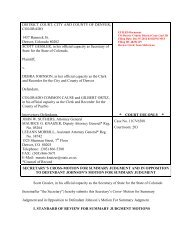
![Download the Letter [PDF] - Brennan Center for Justice](https://img.yumpu.com/50139248/1/190x245/download-the-letter-pdf-brennan-center-for-justice.jpg?quality=85)
